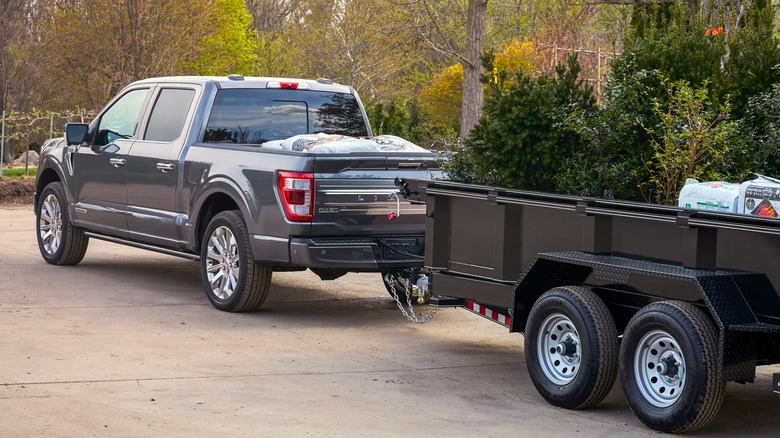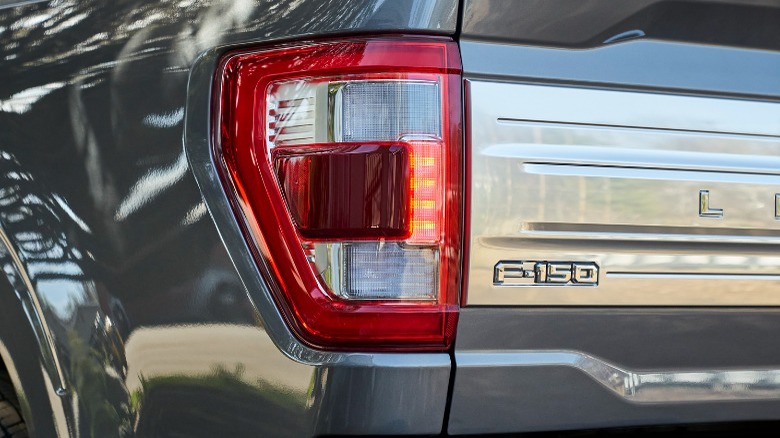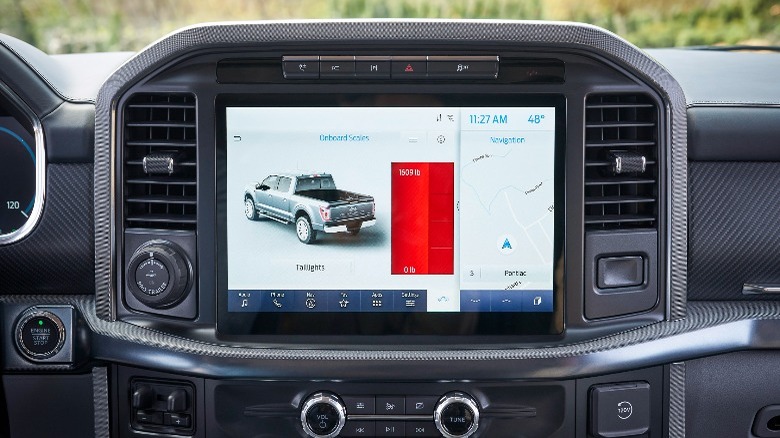These Ford Pickup Lights Hide A Feature Every Truck Should Have
The Ford F-150 has been America's best-selling vehicle for decades. As CNBC reports, recent models are continuing that sales trends. The iconic F-150 has stepped a ways out of its initial intended audience over the years, becoming just as common in mall and school parking lots as construction sites, but that doesn't mean Ford has forgotten its working class roots.
In 2021, Ford added optional Onboard Scales with Smart Hitch to the F-150 and F-150 Lightning lineup, starting with the Lariat trim. This $650 upgrade can be used to weigh the bed payload and trailer weight. A feature that is sure to be a welcome addition for construction workers as much as weekend warriors that like to hitch a trailer and go camping once in a while.
If you think about it, it makes perfect sense to include a feature like scales in a pickup truck — if you know how much you're loading, you can make sure you're not overloading it. Ford took the idea and ran with it, making it incredibly well-thought out and user-friendly by adding a readout to the rear indicators.
Ford Onboard Scales can measure payload from inside or out
In vehicles equipped with Onboard Scales, the tail light is broken up into four vertical segments that gradually illuminate as the weight on the bed or trailer hitch increases. Each portion of the LED represents 25 percent of the maximum permissible weight, which will vary depending on your specific vehicle's configuration. When you max out the bed or hitch, the topmost light will blink a few times to warn you that you're taking your truck's well-being in your own hands (per Ford).
It may seem arbitrary and unnecessary to include the weight readout in the rear indicators when the FordPass app exists, and the car displays an accurate read-out in the cabin. Having a weight indicator in the rear taillights makes far more sense when you consider who is using the feature, and where they are using it.
Firstly, when you need to check the weight of a payload, you're checking to get an estimate of how much you can still load before you overload it, or you're making sure you didn't actually overload the bed. Secondly, the type of people using Onboard Scales may be wearing gloves, have dirty hands, or simply not care for an app.
Onboard Scales links up with other Onboard tech to improve quality of life
If you want a more detailed readout or want to know the exact weight of your trailer or bed payload, you can use the display in the cabin to get more information. If your truck has Continuously Controlled Damping, the system will use the information gathered from the Onboard Scales to adjust the suspension damping and stiffness to improve handling, safety, and efficiency with the added weight (via Ford).
Ford also claims that the F-150 Lightning uses Onboard Scales and clever software trickery to provide accurate range estimates for drivers of the all-electric pick-up. While Ford equips the F150 Lightning with a variety of other tricks to give owners with range anxiety peace of mind, simply knowing how far you can go in a trip goes a long way.
The F-150 is, after all, the quintessential American work truck, and if Ford wants to keep its solid reputation as a work truck, it will have to distinguish itself from the competition with more than just performance.


